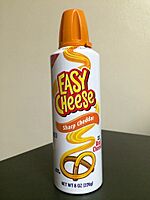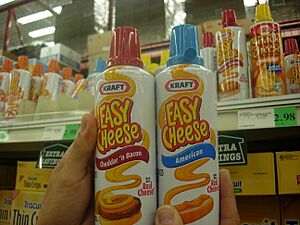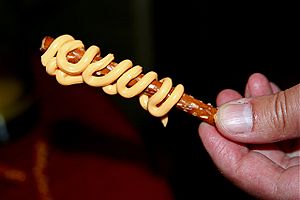Easy Cheese facts for kids
 |
|

An 8 oz (230 g) can of Easy Cheese
|
|
| Owner | Mondelēz International |
|---|---|
| Introduced | 1965 |
| Previous owners | Nabisco |
Easy Cheese is a fun and easy-to-use processed cheese spread that comes in a metal can. You might also hear people call it "spray cheese" or "cheese in a can." It's made by a company called Mondelēz International. The can has a special nozzle that lets you squirt out the cheese, making it perfect for snacks and parties.
A similar product first appeared in 1963. Easy Cheese itself was first made by Nabisco in 1965. Back then, it was called "Snack Mate." Advertisements from the 1960s showed the orange cheese looking fancy on different appetizers. One ad from 1966 even called it "instant cheese for instant parties." Today, you can find Easy Cheese in Cheddar and American flavors. Over the years, there have been many other flavors that are no longer made, like Pimento, French Onion, and Nacho.

Contents
What's Inside Easy Cheese?
Easy Cheese is made from a mix of ingredients that give it its unique texture and flavor. These ingredients include milk, water, and different milk proteins. It also has canola oil and special salts like sodium citrate and sodium phosphate. These salts help make the cheese smooth and spreadable. Other ingredients like lactic acid, sorbic acid, and enzymes are also used.
How Easy Cheese Works
Easy Cheese is designed to be squirted out of its can easily, but then hold its shape. This is because of how it's made and the ingredients it contains.
Cheese Structure
Easy Cheese is like a mix of oil and water, called an emulsion. Imagine tiny drops of oil spread out evenly in water. Special ingredients called emulsifying agents help keep the oil and water mixed together. These agents make sure the cheese stays smooth and doesn't separate while it's in the can. When the cheese mixture is heated during making, these agents help everything blend perfectly.
Why It Sprays and Stays
Have you ever noticed how Easy Cheese comes out like a liquid but then quickly becomes solid? This is a cool science trick! When you push the cheese out of the can, it acts more like a liquid, flowing easily. But as soon as it's out and you stop pushing, it becomes thicker and holds its shape, like a solid.
This special behavior is partly due to an ingredient called sodium alginate. It helps create a gel-like network in the cheese. This network allows the cheese to change how it flows depending on how much pressure is put on it. So, it's soft enough to squirt but firm enough to stay put on your cracker!

See also
 In Spanish: Easy Cheese para niños
In Spanish: Easy Cheese para niños

